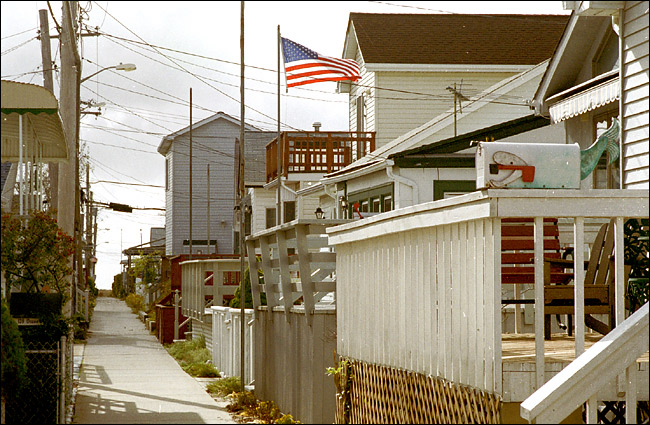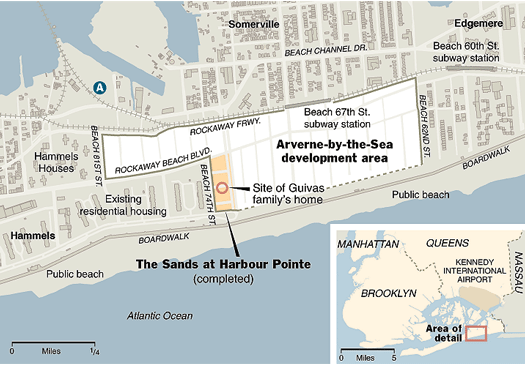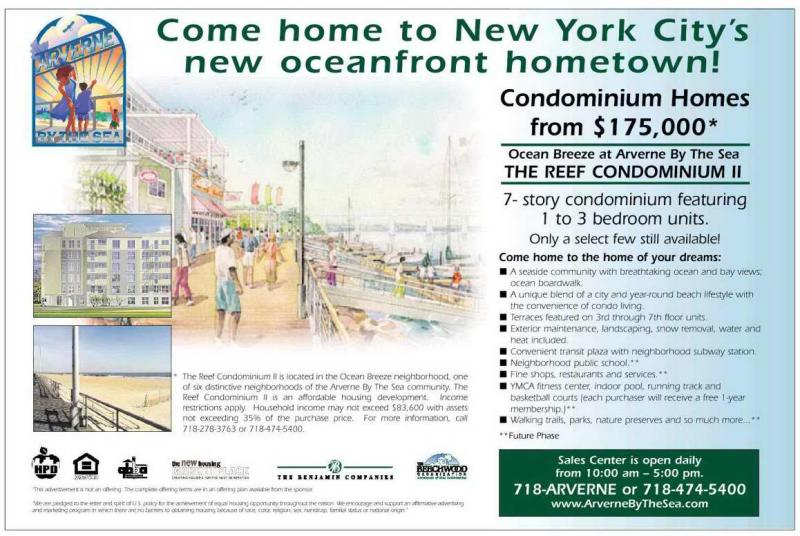In The Rockaways, a Tide Is Coming In
By DENNIS HEVESI
 |
The initial 32 two-family homes have been built at Arverne by
the Sea on part of the
long-dormant 308-acre Arverne Urban Renewal Area located at 73rd
Street and Ocean Front Parkway.
YOU can't buy a kewpie doll or a Tuckee Cup on the boardwalk in the Rockaways any more. The arcades are long gone.
But Michael and Donna Mark bought a two-family house behind a white picket fence three blocks from the ocean on Beach 60th Street for $246,000 two years ago. And in September, the house, in the Arverne section, was reappraised at $310,000 — a 26 percent increase in value.
"We thought the price was good because we saw a lot of potential in the area," said Mr. Mark, 38, an investigator for the New York State Insurance Department. "Now, it's exciting to see all the development around us. And the newest homes are going for $400,000."
Things are looking up along the 11-mile sand spit on the south shore of Queens that used to be known as "the poor man's Riviera" — particularly at its midriff, where vast swaths of land once crammed with summer bungalows have lain desolate for decades, orphans of urban nonrenewal.
Howard Schwach has watched the tides turn.
A native son, Mr. Schwach, 64, is managing editor of the peninsula's 110-year-old weekly newspaper, The Wave. He waxes nostalgic about his adolescent adventures along the boardwalk. "We joke that you're an old-time Rockaway resident if you remember the Tuckee Cup," Mr. Schwach said, explaining that it was chow mein in a cup made of pressed noodles that cost $1.25 back in the 50's. "So you would eat the stuff out of it with a wooden fork they gave you, and then when you were finished you would eat the cup."
Back then, Mr. Schwach continued: "The boardwalk was lined with stores and penny arcades, two movie theaters. Sometimes in the summer you slept on the beach; there was no air-conditioning. And it was great to be a teenage boy because thousands of teenage girls would flock to the Rockaways; summer romances were the thing."
Then, in the early 60's — some say particularly because of the coming of the jet age and fast flights to tropical climes — the Rockaway economy took a turn toward the terrible. The city, in what one local official termed one of its "urban renewal binges," tore down thousands of bungalows, leaving wide tracts vacant or dotting them with low-income housing projects.
"For 35 years we've been sitting here waiting for something to happen," Mr. Schwach said, "and now it is."
Using the two-family home as a sort of standard model (with one unit potentially providing rental income), builders have speckled the peninsula with hundreds of new houses over the last five years — three or four scattered among tattered though tenacious bungalows on this street or that; five square blocks lined with three-story town houses; acres blanketed by a hundred semiattached homes here, two dozen detached there, nearer to the surf.
To be sure, there are those concerned that the seaside way of summer life is facing extinction, and that there is insufficient infrastructure — roads, sewers and schools — to support all the new development on the peninsula. Lots of new houses have certainly been built.
And they've sold.
In 1999, the Briarwood Organization took a chance by building 40 two-family homes between Beach 59th and 61st Streets for a project called Waters Edge — a sliver from the long-dormant, rubble-strewn, 308-acre Arverne Urban Renewal Area that dominates the Rockaways' central corridor.
Despite buying the city-owned land through the Department of Housing Preservation and Development at only $1,000 for each promised housing unit, and agreeing to pass along the land-cost savings to new homeowners, said Briarwood's president, Vincent Riso, "It took us awhile to convince people to purchase."
"We were the first new construction in Arverne in 30 years," Mr. Riso said. "But once we started our sales program, we found a number of lovely families who bought and are now our best salespeople. Our sales staff tells buyers, `Don't feel shy, just go down the street and ring doorbells.' "
All of the original 40 homes, except the demonstration model, are now occupied; sold at an average price of $228,000. And in the second phase of the project, 65 more two-family houses are to be built starting in February.
"We found Arverne to have a slow kindling point," Mr. Riso said. "But now that we've been there awhile, we have no concern that we won't sell out these 65 new homes quickly" — at about $400,000, with no subsidy.
The First Spark
Cookie-Cutter Homes at $170,000 Each
If Waters Edge was the kindling point for real renewal in Arverne on the ocean side of the Rockaways, then the spark for the entire peninsula may have been lit a decade ago in Sommerville — a stub of land poking toward the tiny islands and sand hassocks, splayed with straw-gold stretches of marsh grass, that dot Jamaica Bay to the north. That, at least, is the contention of Vincent Castellano, the housing chairman for Community Board 14.
"There are three blocks around 63rd Street that, to me, started the building boom in the Rockaways about 10 years ago," Mr. Castellano said. A fledgling developer, Malcolm Smith, built 60 homes on that long-vacant land.
"Everybody thought he was crazy," Mr. Castellano said. "The price at the time was $170,000 for these cookie-cutter homes. But they sold."
And while there was criticism of the project's look-alike architecture back then, just as the Levittown box soon blossomed with add-ons and build-ups, much of Sommerville has been customized over the years. "That was the beginning, the first time a private developer put his money on the barrel," Mr. Castellano said. "And that gave confidence to other developers." In 2000, Mr. Smith, the developer, was elected to the State Senate.
For nearly a century, Rockaways' Playland — with its water slide, Olympic-sized swimming pool and amusement-studded midway — drew thousands of fun seekers to its site between Beach 97th and 98th Streets, from Rockaway Beach Boulevard to the boardwalk. In 1938, a 300-foot-long, 70-foot-high wooden roller coaster — later dubbed the Atom Smasher — first plunged riders toward that faint line between thrill and terror.
By the late 80's, the Atom Smasher, along with the rest of Playland, squeezed by dwindling attendance and skyrocketing insurance costs, had been reduced to rubble — little but its foundation to lie forlorn for nearly a decade.
Now, beside and to the south of the elevated A-line train stop that still bears a Playland station sign, 110 two-family homes have been built and sold by Rockaway Shore L.L.C. And 30 more are under construction.
"Our first homes were priced around $250,000," said Jonathan Miller, a partner in the company, pointing out that several parcels outside of the Playland site have been incorporated into the development. "Today, three years later, they sell for around $450,000," without any subsidy.
"It's still affordable," Mr. Miller continued, "because these are two-families. So when the buyer takes into consideration today's interest rates and the rental income, the house becomes affordable."
The company is also building 92 two- and three-bedroom apartments in three-story buildings off the southeast corner of Cross Bay Parkway and Rockaway Beach Boulevard. Rents there will range from $1,300 to $1,500 a month, with tenants required to have incomes between $44,600 and $157,000.
Other developers and city officials had high-rise designs for the Playland property and the vast Arverne site during the fallow years. "They made a lot of promises to the residents of the Rockaways," Mr. Miller said, "but none were fulfilled."
These days, to a greater degree, commitments are being kept.
Improvements are tangible at the six public housing projects with 4,000 apartments that dot the eastern stretch of the peninsula. For years, local residents and officials have complained that the Rockaways have borne an unfair share of the city's homeless and low-income burden.
"The housing projects have become less of a sore point," said Jonathan Gaska, the district manager of Community Board 14. "Over the last five years, the housing authority and the police, in partnership with the tenants, have really changed things for the better as far as crime. They are doing more security in the buildings and on the grounds."
At the Arverne and Edgemere Houses, particularly, Mr. Gaska said, "The housing authority has spent a significant amount of money renovating all the apartments, thousands of units."
And in the Edgemere Urban Renewal Area, on the bay side of the A-train line from Beach 32nd to 54th Streets, 400 two-family houses are being built, part of the Department of Housing Preservation and Development's commitment to promote homeownership in less affluent neighborhoods. "This is in cooperation with the New York City Housing Partnership program for families with incomes as low as $35,000, and up to $75,000," Mr. Gaska said. "They're done with the first phase, 60 houses, in the $300,000 range."
The Rockaways may even become a bit artsy, one artist hopes.
For two and a half years, Richard Kostelanetz, 63, a media artist and writer who currently lives in Manhattan's SoHo district, has been building what he calls, with mordant humor, his "terminal residence" at Kohlrider Square in the Rockaways, a two-block-long park on the bay side of the elevated line at 67th Street.
"I'm building a 4,000-square-foot home and studio; pretty eccentric looking," he said, "cinder block, a few windows high up, skylights, tall ceilings."
Mr. Kostelanetz is the author of "SoHo: The Rise and Fall of an Artists' Colony" (2003, Routledge), an account of the effects of gentrification in that downtown Manhattan neighborhood. He is currently writing "The Fall and Rise of the Rockaways" (no publisher signed yet).
"I'm a New Yorker, so I can't leave New York," he said. "I'm also a beach boy; I wanted to be near the ocean." A lesser, but added, pleasure is the last long leg of the A line "over Jamaica Bay, the most beautiful subway ride in the city."
In the short time that Mr. Kostelanetz has been working on his Rockaway home, he said: "All the empty lots — and there were many of them in my neighborhood — were snapped up. There's six two-family buildings on my block that have gone up in the last two years."
An Array of Projects
From Mansions to Town Houses
From the east to the west ends of the peninsula, lots of lots have been snapped up. In Far Rockaway, near the Nassau County border, four-story, Spanish revival-style mansions have risen where suburban ranches once stood. "They've started to call it West Lawrence," said Mr. Castellano, the housing chairman for the community board — a covetous reference to one of Nassau's affluent Five Towns, just across the city line.
Nearby, in Bayswater and Edgemere, the Leewood Real Estate Group and the Housing Partnership are building Ocean Pointe, a development of 100 town houses for families with incomes ranging from $52,000 to $79,000. The homes will sell for between $275,000 and $289,000. But 79 are eligible for approximately $55,000 in land-cost and cash subsidies through H.P.D. and the New York State Affordable Housing Corporation, a subsidiary of the state Housing Finance Agency.
In Neponsit, one of the westernmost communities on the peninsula — within a harrier hawk's take-off flight path from the dunes at Gateway National Recreation Area — opulent new homes with bay windows and balconies yawning toward the ocean have nestled among their long-established neighbors.
Few, if any, Rockaway residents have a better feel for the place than Mr. Castellano, who lives in a house he built to replace the bungalow in Breezy Point, at the western end, that his aunt bought for $4,000 in the mid-50's. It is only 10 feet from an unconverted bungalow, in a row of similarly spaced residences on a narrow path to the beach.
"If you have a fight with your wife, the next morning all the neighbors vote," he said.
"When you look at it lengthwise," Mr. Castellano said of the entire peninsula, "there's a different neighborhood every 10 blocks. And it's only a slight exaggeration to say that they each have their own name, their own political club, civic association, agenda, income category and ethnic mix. And they are all very jealous of their little fiefdoms."
"If you want to make enemies quickly," he said, "go into one neighborhood and refer to it by the name of the next neighborhood. You can't go to Neponsit and refer to it as Belle Harbor — and no, there's no `u' in harbor, not yet anyway."
The community board, Mr. Castellano said, has "seen situations where, if one neighborhood is getting some kind of municipal improvement, the adjoining neighborhood will object unless they get something, too."
Yet, if there is anything that, perhaps, most Rockaway residents might agree upon — though there are some involved in long legal struggles to insure that not all the bungalows fall — it is that something hopeful is happening in the 308-acre Arverne wasteland.
For nearly four decades, grand plans were offered for the 52-block stretch from Beach 32nd to 84th Streets, between Rockaway Beach Boulevard and the boardwalk. They fell through.
In the late 80's, Forest City Ratner proposed construction of a phalanx of mid- and high-rise condominium and rental apartment buildings on the site. But, with the collapse of the real estate market in the early 90's, that plan went by the boards.
Then, in the late 90's, a division of the Reichmann family real estate conglomerate in Canada planned to build — for more than $1 billion — an enclosed amusement area on the Arverne site, to be called Destination Technodome, with rides, movie theaters, an indoor ski slope and a hotel.
But as Mr. Gaska, Community Board 14's district manager, pointed out, the developer and the community "needed a commitment from the city and the state for infrastructure work, anywhere from $250 million to almost $1 billion for sewers, roadways, another exit off the Belt Parkway." That commitment never came.
Arverne by the Sea
Two-Family Homes in the Wasteland
Now, far more than a commitment has been made for Arverne by the Sea — a multifaceted development already rising on the western 117 acres of the urban renewal area. Most of the initial 32 two-family homes — models for what is to come — have been built on a three-acre site between Beach 73rd and 74th Streets. Those homes, in clusters of up to six in a row, will range in price from $395,000 to $495,000.
On Nov. 19, the City Council gave final approval to the land-use plan for the rest of Arverne by the Sea. "We'll be building an additional 650 two-family homes and another 1,000 units in midrise buildings, five to 11 stories," said Peter Florey, executive vice president of the Benjamin Development Company, which, in partnership with the Beechwood Organization, is the city-designated developer for the site.
Most of the midrise buildings will be located along a residential/retail corridor running from the Beach 68th Street train station to the boardwalk. "It will be known as Ocean Way, one of the new streets," Mr. Florey said. "The buildings will be a combination of market-rate rentals and condos."
Beechwood-Benjamin bought the land from the city for $8.6 million. "We are paying for all infrastructure costs," Mr. Florey said, "including all roads, storm and sanitary sewers. And we are building a 30,000-square-foot community center and an 800-seat elementary school on about three acres at Beach 67th Street." He estimated the infrastructure costs at $80 million.
The Department of Housing Preservation and Development projects that by 2009, there will be 2,300 housing units at Arverne by the Sea, and a total of 4,000 for the entire urban renewal site; an Arverne Central Park (planned as a nature park and dune preserve) and up to 500,000 square feet of commercial and retail space on the eastern portion of the site.
Seeming resolutely proud of it all, Mr. Gaska, of the community board,
said: "There are those who doubted this day would ever come. They said
nothing would ever get built. We've proved them wrong."
 |
Ocean Avenue, a part of Breezy Point where no cars are allowed.
 |
 |
Back to Rockaway Beach Home Page
